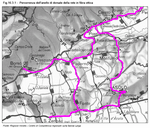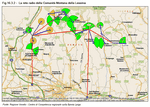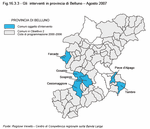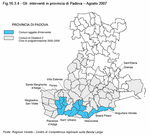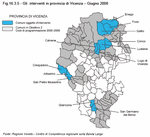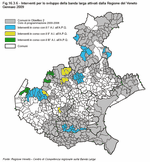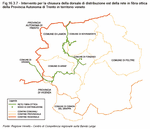Following the results of the survey on broadband coverage in the region, Regione Veneto has created projects which mainly aim to provide for those areas still without coverage. This concerns mainly the mountain, rural and outlying areas, as well as the areas covered in the EU 2000-2006 plans and in the State Aid Action plans. These are parts of the region which are suffering from "market failure" where the private providers lack the resources and financial means to act autonomously due to the geographical, social and economic features of these areas.
In 2006, Regione Veneto set up some initiatives to overcome the digital divide in the region, financing work on infrastructure by the local authorities using resources set out in the first Integrated Act of the Framework Programme Agreement on the Information Society.
Starting from 2007, the planning and the carrying out of measures to provide greater broadband coverage were included in the "Operational Plan on broadband", a particularly action-based paper, in order to give a coordinated and well-structured direction to regional policies for the development of the information society.
The Pedemontana del Grappa and Asolo broadband network
Work consisted in creating a fibre optic backbone network of around 36 kilometres to connect the municipalities of Asolo, Borso del Grappa, Castelcucco, Cavaso del Tomba, Crespano del Grappa, Fonte, Monfumo, Paderno del Grappa, Possagno and S. Zenone degli Ezzelini.
The network is made up of a backbone ring to which a series of access networks were connected, each of which was developed starting from the backbone
(Figure 16.3.1).
It is believed that the backbone infrastructure should be created using fibre optics as the speed and the distances in play are constant, whereas radio technology is more suitable for further extending broadband coverage over the area from the backbone out, both in terms of cost and of time involved. This leads to a situation in which the two technologies complement each other, with an important fibre optic topological skeleton and local branches using radio.
When carrying out the work, as well as traditional digging techniques, the aim is to use optic cable laying methods which limit the impact on the area and speed up the creation of the broadband network. These methods include digging small channels and using the lines for street lights or any abandoned lines, which enables cost reductions as it makes use of technology already present and available on many streets.
Along the optic backbone some key nodes, known as points of presence (POP), have also been designed and created; the distribution network unravels from them towards the various places to connect up.
Development of a centralised local information system for the Lessinia mountain community
The project consists in the creation of a broadband infrastructure network to connect the municipalities in the Lessinia mountain community: Badia Calavena, Bosco Chiesanuova, Dolcè, Erbezzo, Fumane, Roverè Veronese, S. Mauro di Saline, S. Anna d'Alfaedo, Selva di Progno, Velo Veronese and Vestenanova.
Taking into account also the orographical features of the area in question, the most suitable technical solution consisted in the planning of a telematic network using PDH and HiperLAN wireless technologies at 5.4 GHz to create the radio backbone. The first level of the backbone network is made up of a PDH radio link ring with a 100 Mbps capacity, which connects the points of presence in Monte Pastello and Velo Veronese; the second level of the backbone network will be made up of HiperLAN point-to-point links
(Figure 16.3.2).
Project for the provision of connection services in the province of Padova (Bassa Padovana) and in the province of Belluno.
At the end of 2007, the "Restricted procedure for the provision of connection services in the province of Padova (Bassa Padovana) and in the province of Belluno" was decided upon. This will guarantee broadband coverage in the municipalities of Cesiomaggiore, Tambre, Pieve d'Alpago, Sospirolo, Gosaldo and Falcade in the province of Belluno, and in the municipalities of Anguillara, Boara Pisani, Megliadino San Vitale, Piacenza d'Adige, Santa Margherita d'Adige, Sant'Urbano, Villa Estense, Granze, Ponso, S. Elena and Vescovana in the province of Padova.
Each piece of work, which includes the creation of the infrastructure, the activation and maintenance of the service, takes 48 months, plus 24 months to guarantee continuity; the service was activated in September 2008
(Figure 16.3.3) and
(Figure 16.3.4).
Project for the provision of connection services in the province of Vicenza
In December 2008 the results of the competition assigning financial contributions towards providing broadband coverage in some municipalities and sub-municipal areas in the province of Vicenza were approved. The municipalities in question are Grancona, S. Germano dei Berici, S. Pietro Mussolino, Crespadoro, Altissimo, Lusiana, Lugo, Calvene, Conco, Foza, Enego and Gallio.
The competition winner proposed using WIMAX technology to provide the service
(Figure 16.3.5).
Development of a centralised local information system for the Baldo mountain community
In July 2009, a convention was signed between Regione Veneto and the Baldo mountain community for the creation of a broadband infrastructure network to connect the municipalities in the Baldo mountain community. Regione Veneto and the Lessinia and Baldo mountain communities pledged to collaborate to broaden the project and to reuse the "Lessinia Net" project to the benefit of the Baldo mountain community; the project covered the municipalities of Brentino Belluno, Ferrara di Monte Baldo and San Zeno di Montagna, all of which are areas included in the EU 2000-2006 programming (Objective 2). The project, which comes under the 3rd Integrated Act of the Framework Programme 7 Agreement on the subject of e-Government and Information Society, is due to be completed at the beginning of 2010. Work aims to broaden to new areas the telecommunications infrastructure already created in the Lessinia mountain community, provide broadband access for the public administration, plus small- and medium-sized businesses and residents, as well as reuse the regional "MyPortal" project; the aim is also to extend the network created for the Lessinia mountain community to the above-mentioned municipalities in the Baldo mountain community through the creation of a web portal containing general and institutional information as well as news on tourist and/or promotional events in the area.
Project for wireless infrastructure in the Valle d'Astico and Posina mountain community
The project, which consists in the creation of a wireless infrastructure to provide broadband coverage in the Alto Astico and Posina mountain community, comes under the 3rd Integrated Act of the Framework Programme 7 Agreement on the subject of e-Government and Information Society. The project is due to be completed in 2010. The aim is to create a telecommunications infrastructure to provide broadband access in the mountain community, namely in the municipalities of Arsiero, Cogollo del Cengio, Laghi, Lastebasse, Pedemonte, Posina, Tonezza del Cimone, Valdastico and Velo d'Astico. The project uses wireless technology.
Project for the provision of connection services in the province of Belluno.
At the end of 2009 the
"Restricted procedure for the provision of connection services in the province of Belluno" was decided upon. This will guarantee broadband coverage in the municipalities of Vigo di Cadore, Cibiana di Cadore, Ospitale di Cadore, Zoppè di Cadore, Soverzene, Lamon, Perarolo, Feltre, Mel, Alleghe, Rocca Pietore and Auronzo di Cadore. The executive project is being prepared and provision of the service is expected by 2010.
An overall view of the projects set up and carried out by Regione Veneto, using CIPE (Interministerial Committee for Economic Planning) provided through the three Integrated Acts of the Framework Programme 7 Agreement on the subject of e-Government and Information Society can be seen in the map 16.3.6
(Figure 16.3.6).
Creation of a broadband network through the closure of the eastern distribution backbone of the fibre optic network in the autonomous province of Trento through connections to the bordering municipalities in the provinces of Belluno and Vicenza
Another project, different in type to those followed by Regione Veneto up to now, involves the closure of the eastern distribution backbone of the fibre optic network in the autonomous province of Trento through connections to the bordering municipalities in the provinces of Belluno and Vicenza. This involves the municipalities of Arsiè, Feltre, Fonzaso, Lamon, Sovramonte in the province of Belluno and Cismon del Grappa in the province of Vicenza.
With the creation of a fibre optic network of around 50 km, this section of Belluno will be provided with an important connection infrastructure which will innovate and increase the services provided by the local public administration and will also encourage initiatives from private telecommunication providers to whom the network will be made available.
This project will affect around 12,000 inhabitants. Fibre optic cable will be laid by using mainly small channels with 6 pipes being set down, by using bundles of 144 and 288 fibres and by creating 5 distribution nodes (shelters) at strategic points along the network.
The project is co-financed by Programma Intesa (Regional Law no. 31/2007), the autonomous province of Trento, Regione Veneto, the province of Belluno and Consorzio BIM Piave
(Figure 16.3.7).






